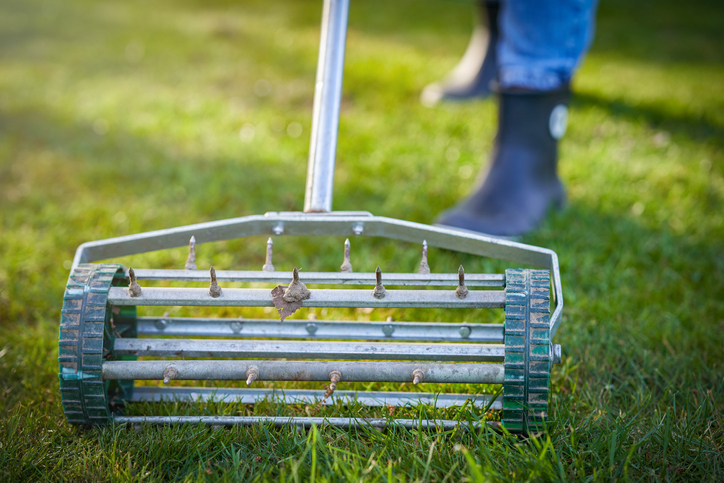How to aerate a lawn — plus when you should do it
Aeration can improve surface drainage, soil structure, and helps grass grow. Here's our guide on how to do it

Aeration is an often-overlooked aspect of garden landscaping that involves perforating the soil with small holes to allow air, water and nutrients to penetrate to the grass roots and improve the overall health of a lawn.
The main reason for aerating is to tackle soil compaction, where too many solid particles in a certain volume or space prevent proper circulation of air, water and nutrients within the soil.
Homebuilding and Renovating spoke to lawn expert David Hedges Gower, chairman of The Lawn Association, for extensive advice on all aspects of garden aeration.
Why should you aerate a lawn?
Aerating a lawn isn't merely about poking holes, it's about reinstating the balance of air and water in the soil. Ideally, soils should maintain around 25% water storage and 25% air space.
Natural occurrences like droughts or excessive rainfall can upset this balance, impacting soil structure. Aeration, particularly using a hollow tiner, is the most effective method, aiding in improving surface drainage, soil structure, and facilitating the growth of grass through enhanced access to fertilisers, natural rainfall, and deeper root systems.
Using a garden fork, though, adds holes, which can potentially lead to compaction issues on various soils and is better suited for specific areas like a vegetable patch.
When should you be aerating your lawn?
Aeration allows water to percolate through the soil and dries it out – that’s what it’s for of course.
Hence, it's best to avoid aerating during dry spells or summers. The optimal time for aeration typically spans from September through May when wetter periods occur, allowing for better soil manipulation. Leaving the holes open post-aeration, in most cases, aids continuous water movement through the soil. There's generally no need to fill these holes with sand: we're nurturing a lawn, not preparing a golf-putting surface.
Aeration serves as a vital winter preparation step, beneficial regardless of how meticulously you maintain your lawn. Most issues arise from overly wet soils or excessive thatch. As winter tends to be cold and wet for extended periods, ensuring adequate airflow and drainage becomes essential for the lawn's winter survival.
It’s the one thing any expert would suggest – aeration, aeration, aeration!
It can also help to remove thatch by vigorously raking with a lawn rake. Mounds of moss and dead grass will come up, which is a good sign.
How do you aerate a lawn?
There are three primary methods for lawn aeration, easily executed with either a machine or handheld tools for smaller lawns:
Hollow tine aeration: This technique, though potentially harder work, is the most effective for lawns. Tools like the Step 'N Tilt Core Lawn Aerator from Amazon simplify this process by extracting tiny cores of soil to create holes. Doing this annually leads to consistent soil improvement and stronger, more resilient grasses. Depending on how the tool you have works, you push the tool into the ground to extract these cores of soil.
Solid tine aeration: This method primarily creates holes but doesn't alleviate compaction effectively. While it's not designed for this purpose, it might be suitable for maintaining already ideal soils, although it's a challenging and possibly temporary solution. A solid tining tool works by pushing holes into the ground, this can be a machine that you push along so spikes on a roller go into the ground.
Slit tine aeration: This non-disruptive method allows water percolation and light pruning of native grasses. However, its impact on soil is minimal, requiring frequent effort for noticeable effects, much like using a garden fork.
David adds: “Aeration or soil improvement stands as a cornerstone for any lawn, be it a croquet lawn or a wild meadow. It fulfils the dream of maintaining a healthier growing medium for every lawn. Staying proactive is crucial, considering the unpredictability of nature. Hence, selecting the right operation tailored to your specific lawn needs is paramount.”

David Hedges-Gower is the UK's most trusted lawn expert. He is the chairman of The Lawn Association, an educational platform for homeowners, professionals and media. In addition, David also launched True Garden Range, the world's first 2-in-1 fertilisers and soil conditioners, made from composted recycled food waste.
Get the Homebuilding & Renovating Newsletter
Bring your dream home to life with expert advice, how to guides and design inspiration. Sign up for our newsletter and get two free tickets to a Homebuilding & Renovating Show near you.
Sam is based in Coventry and has been a news reporter for nearly 20 years. His work has featured in the Mirror, The Sun, MailOnline, the Independent, and news outlets throughout the world. As a copywriter, he has written for clients as diverse as Saint-Gobain, Michelin, Halfords Autocentre, Great British Heating, and Irwin Industrial Tools. During the pandemic, he converted a van into a mini-camper and is currently planning to convert his shed into an office and Star Wars shrine.

